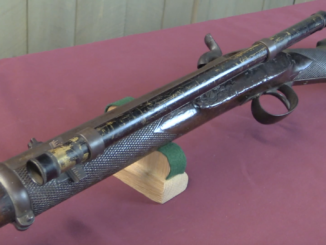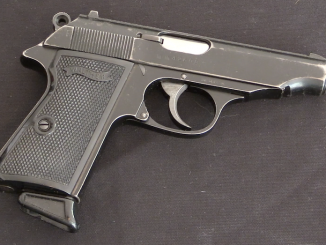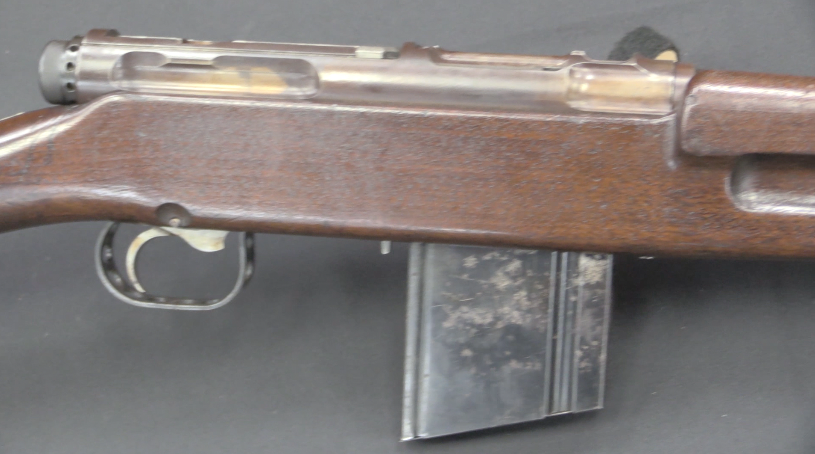Webley introduced their No5 Express New Army model revolver in 1878. This was essentially a ruggedized and scaled up variation on the No5 RIC revolvers that was very popular with police forces. The RIC was chambered for just the .450 Adams cartridge, and its ejection system in particular was not suitable to serious military campaigning. Hoping for a military contract, Webley took that No5 double-action clockwork and put it into a much bigger frame, capable of handling all patterns of British service cartridge as well as the American .45 Colt powerhouse. It then proceeded to lose the military adoption to the Enfield MkI, a frankly not very good design.
However, British officers had their own choice of sidearms, and many opted for the No5 Army Express, as evidenced by significant sales through the Army & Navy CSL catalog. The model was well liked and popular, but only for a fairly brief span. In 1887 the British adopted the top-break Webley MkI, and the development of new technology like smokeless powder and tip-out cylinders quickly rendered the No5 obsolete. But for about a decade, this was a very compelling choice, offering a reliably double action system with a powerful cartridge.




No.5 RIC??? NO such critter‼️
only 5 soid frames ever produced if you include the New Model No1 and the “New Model RIC” in .476CF
“(…)capable of handling all patterns of British service cartridge as well as the American .45 Colt powerhouse(…)”
Wait, this does include .450 Adams and .45 Long Colt. They do greatly differ in muzzle velocity (first around 200 m/s, second around 300 m/s), which raise question: how were sights adjusted: for 1st, for 2nd or some compromise setting?
yes…also .455CF
yes…also .455CF
they were chambered and proofed for the different cartridges.
“… how were sights adjusted”
I suspect the answer is: not at all and that these were intend for use at what amounts to point blank range, where the ballistic curve of the projectile is negligible.
‼️
Y’know… If you find yourself in a tactical situation wherein the ballistic arc of a pistol round is something of importance…?
I’m pretty sure you’ve made some other significant life choices which are about to immanentize your eschaton such that you no longer need worry much about anything ballistics-related.
In plain English, if you ever have to worry about the arc of your trajectory from a handgun, you done f*cked up. The necessity to provide indirect fire from a pistol is not normally an “envisioned scenario” for any designers, anywhere. If you manage to create such a scenario, somehow…? I have limited hopes for your future prospects.
Long-range shooting with a handgun is more of a sportsman’s thing. Or else it’s like IPSC competition, the handgunners’ equivalent of golf.
Cooper and Keith advocated learning to use the .44 Magnum revolver at ridiculously long ranges (over 200 meters). Cooper stated that “A good shot, taking his time and firing from a proper position (he meant “sitting and leaning back against a tree and using both hands”) is a deadly adversary at 200 yards with a .44 magnum”.
Well, yes, but my choice in .44 for that sort of shooting would be something more like a Rossi M92 .44 lever-action with a 24″ barrel. Although exactly why I’d even be trying it I am unable to adequately explain even to myself. If I want to shoot at something beyond 100 meters, I’m getting a rifle with a telescopic sight in something like 7.62 x 51mm.
In law enforcement training, we use the “seven yard rule”. Most assaults with or without firearms are within seven yards’ distance. Generally, that seven yard “band” is where you want the suspect stopped before he can use a knife or etc. on you.
And yes, somebody with a knife can injure or kill you before you can react if he’s closer than that. Human beings, especially ones amped up on drugs, adrenaline and/or basic anger or craziness, can move surprisingly quickly. And since you are reacting rather than initiating, you are always going to be “behind the curve” of the Immediate Action by definition.
Statistically, about nine out of ten shots fired at seven yards or less…miss. Adrenaline surge can affect you, too.
In my personal opinion, today too much emphasis is placed on training officers (and civilians) to “go to Weaver” and shoot with as near rifle-like precision as possible. Watch a few “police pursuit” bodycam/dashcam videos on YT and you’ll see how seldom police actually hit anything that way. The two dumbest things officers are trained to do today are “going to Weaver” even at arm’s length range, and the “mag dump” with the high-capacity 9mm pistol. Only hits count and doing it that way, you generally miss.
Mostly, such “eyewitness” videos build a strong case for “old fashioned” point shooting- with the double-action revolver, preferably in .357 Magnum.
Long-range handgun shooting is an interesting form of recreation, and in certain circumstances (such as the “trail gun”) a necessity when collecting supper. But practically speaking, most of this is better done with a rifle.
In purely tactical “life-saving” terms, the handgun is a defensive weapon for use at close range- under 20 meters. If you’re trying to use itoffensively at ranges much over 50 meters, you’re doing it wrong.
clear ether
eon
brilliant‼️
Agree with both of you. Conceptually the pistol isn’t a compact equivalent of a rifle (which so many writers/trainers have made it). It’s a noisier version of a knife or club with longer reach.
Just to throw in a plug for C&Rsenal’s video on this weapon, in which it is fully disassembled and the lockwork shown off. In my opinion this is a downright beautiful gun in nickel.
I have a No.5 .450CF in nickel and it is beautiful ‼️
I have a No.5 .450CF in nickel and it is beautiful ‼️
ish I could post a pic.